by Marion Scott with research assistance from Fred & Joan Darby, Bob Moore & Ian White
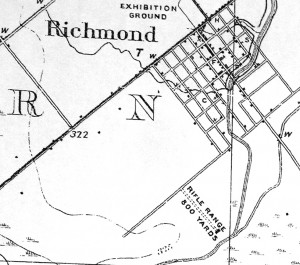
One hundred years ago in the summer of 1914, the great powers of Europe were lurching towards war. Meanwhile, in Richmond, the Strathcona Rifle Range was at the centre of a kerfuffle between the Canadian Northern Railway and the Canadian Government. Why, at a time when the British Empire required all the skilled marksmen it could find, did someone want to close a training ground for riflemen? The answer seemed very simple. The railway executives thought their passengers and trainmen might get shot.
Lord Strathcona Rifle Association
In 1899, as the Canadian Government was organizing a force to fight in the Boer War, Richmond residents were honing their shooting skills. They formed a rifle association, which is noted in various documents in the Department of Militia and Defence as the ‘Richmond Rifle Association’, the ‘Strathcona Rifle Association’ and the ‘Lord Strathcona Rifle Association’. We will call it the Lord Strathcona Rifle Association or the LSRA.
Little is known about the formation of the Lord Strathcona Rifle Association or its members. The very confusion about its name suggests that the members were less interested in the formalities of the group’s organizational structure and more interested in shooting. The LSRA seems to have been popular. In an interview with an Ottawa Citizen reporter on January 30, 1932, John Rielly, who had been the association’s spokesman, said that at the turn of the century there were about 160 members – quite a large number for Richmond and the surrounding area.
The Strathcona Rifle Range
The obvious purpose of the LSRA was to acquire a range where members could improve their shooting skills. In 1902, the LSRA leased land (for 30 years) at the southwestern edge of the village and just north of the ‘Rock Cut’ on the Jock River (close to the present Royal Canadian Legion building). The land had originally been part of the Estate of George Lyon but by 1900 was owned by other families. The LSRA made an agreement with the Department of Militia and Defence, which paid for the building and maintenance of the range.
We don’t know the circumstances surrounding the construction of the rifle range. Was it built because of the course of international events? Was it an inexpensive way of preparing a pool of men for future inclusion in the military? The answer may have involved both factors. Up until this time, Canada had been resisting British pressure to establish a full-time military, relying instead on militia units that could be called for service in time of war. The militia in turn emphasized the recruitment of skilled sharp shooters. Hence a reason for the government to finance a community rifle range.
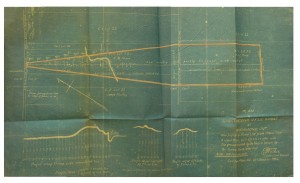
The rifle range had a maximum shooting range of 800 yards from the firing line to the 4 targets. The targets were backstopped by a mound of earth (butts) and directly behind the mound was a trench where ‘spotters’ could seek safety while shooting was occurring.
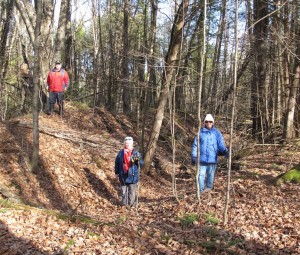
photo by Fred Darby – Nov. 2013
A short distance behind the trench was the stop butt, an enormous mound of earth, which was meant to capture stray bullets. The stop butt was very close to the Jock River. In fact, it was close to where Captain Lyon had once constructed a dam and carding mill. When operating, the mill was located just upstream from what is today locally referred to as the ‘Rock Cut’. The butt was several hundred feet inland from the west end of the dam. You can reach it by following a well-used trail west from the ‘Rock Cut’.
The stop butt was enormous – 90 feet long and 23 feet high.
The mound, which supported the targets, was centered in front of the stop butt and
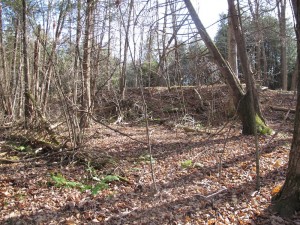
photo by Fred Darby Nov. 2013
appears to have been approximately half as wide and half as high as the stop butt. Beyond it a ‘danger zone’ of vacant land approximately 450 yards (roughly ¼ mile) wide extended on the south side of the Jock River beyond the 2nd line and well into the 1st Concession of Goulbourn. (see Plan)
Both the target mound and stop butt were earthen but the source of this material is unknown. The trench behind the target mound gives the impression that at least some of the soil for the mound came from the trench. But what of the material for the stop butt? Was the fill moved to the area or was it scraped from nearby fields?
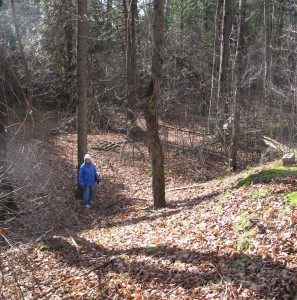
photo by Fred Darby Nov. 2013
Did the inner core contain some other material such as river rock or even rubble from the Lyon mill and dam? Making the stop butt was a large undertaking and an Ottawa firm, O’Leary Brothers, built it.
It seems that initially all went well for the LSRA and the military continued to support the project. For example, in 1911, Thomas Nesbitt, who lived close by, was paid $100 by the government to clear an area of the range where trees and brush were a problem.

photo by Fred Darby Nov. 2013
The Canadian Northern Railway Through Richmond
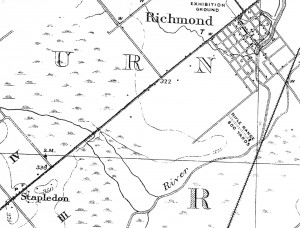
However, trouble was on the horizon. In 1910, the Canadian Northern Railway had begun construction of its main line, which was to join Montreal, Ottawa, and Toronto. The tracks ran along the southern edge of the village of Richmond, next to Jock River and through the middle of the area considered to be the ‘danger zone’ for stray bullets from the Rifle Range. Seemingly the presence of the rifle range remained unknown to the railway executives until the spring of 1914, two years after trains started running on the line! Then the kerfuffle began.
The kerfuffle
May 1914, the month before the assassination of the Archduke Franz Ferdinand, the Superintendent of the Canadian Northern began corresponding directly with the Deputy Minister of the Department of Militia and Defence. At this time the Canadian Northern was working under the misconception that the government was either the owner or lessee of the land.
In a letter dated June 15, the Canadian Northern noted, “… it would not be practicable to allow this range to be used. Will you please be kind enough to advise if the necessary instructions will be issued by your Department so that we may consider that any likelihood of accident is removed?” In a roundabout way, the railway was demanding that the rifle range be closed.
Although the executives at the Canadian Northern claimed to be concerned about the safety of passengers and employees, they provided no examples of bullets crossing the river. Nor is there any indication that they contacted the Lord Strathcona Rifle Association. Since trains had been running through the ‘danger zone’ of the rifle range for the previous two years, one wonders if safety was really the issue or was this just a side bar in an ongoing conflict between the Canadian Northern and the Government of Canada. (You can read more about this conflict at railwaybob.com)
For its part, the military didn’t even know that the tracks were operational and initially demanded that the railway executives find another route.
Finally the two sides got the facts straight but continued to disagree. Both referred the matter to their lawyers but still no one had informed the LSRA. As the summer months passed, and the European powers began to mobilize their armies, the members of the LSRA kept practicing their skills.
In late summer, the military officials finally told the LSRA about the dispute.
The Wrap
On August 12, eight days after Canada entered World War I, an opinion from the Judge Advocate General assured the Department of Militia & Defence that it was in no way liable for any damages that might be caused to the trains or their personnel. “The Crown” should not be a party in the dispute with the railway. The opinion even minimized the role of the LSRA. “They (LSRA) have no greater responsibility to anyone than has the man who takes his rifle or his shotgun and goes out and shoots black squirrels on his land.”
In early September, John Rielly, spokesperson of the LSRA responded to the Department with regards to the railway’s safety concerns. The tone of the reply suggests that Mr. Rielly and the LSRA were completely dumbfounded by the whole business. This letter shows the simple practical solutions, which the villagers suggested to solve a ‘problem’ which they didn’t believe existed:
“With reference to the Lord Strathcona Rifle Association at Richmond. we have never had any complaint as to bullets passing the stop butt. The stop butt is ninety feet long and twenty three feet high. The filling has sunk down two or three feet from the top it would perhaps take fifty or sixty cubic yards of earth to repair it and a few minor repairs to markers butt and gates. We are always very careful when using the range, and never shoot when a train is passing, we generally shoot on Saturdays and have only one more practice to put in to finish the seasons shooting.” (This is a copy of the letter sent by Mr. Rielly and it is unclear if the typos were those of John Rielly or a government clerk.) (The bold type is mine)
Conclusion
So what happened to the LSRA and its Rifle Range? The paper trail ends. Did the Department of Militia and Defence stop funding the maintenance of the range? Did the LSRA continue to operate during the war? After the war? To date no answers have been found. The research continues.
The stop butts, the target mounds, and the observers’ trench still exist, although the erosion of the butts and deposits in the trench have muted their profiles. Trees cover the land around the butts and even the butts. It’s hard to believe that this was once an active rifle range with a clear line-of-sight all the way back to Ottawa Street. This is all that remains of the Strathcona Rifle Range.
Some of the property will become part of the new Mattamy development.
There are many unanswered questions about this Richmond landmark. If you can add information, please contact us.
Bibliography
Chambers, Captain Ernest J. “The Duke of Cornwall’s Own Rifles” A Regimental History of the Forty-Third Regiment, Active Militia of Canada. Ottawa: E. L. Ruddy, 1903.
“Lord Strathcona Rifle Association at Richmond Ontario”. LAC . RG24 volume 6254.
“Richmond Rangers”. Ottawa Citizen. January 30, 1932.
Segment of topographical map of Richmond area. Energy, Mines & Resources, Surveys & Mapping Branch. 1908. LAC NMC 0019569.
“Strathcona Rifle Range”. Goulbourn Township Historical Society file.

2 Responses to Richmond’s Strathcona Rifle Range